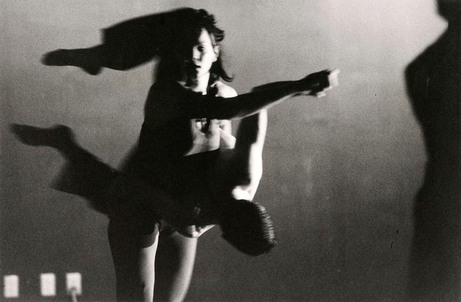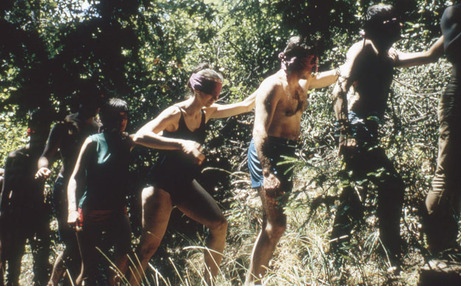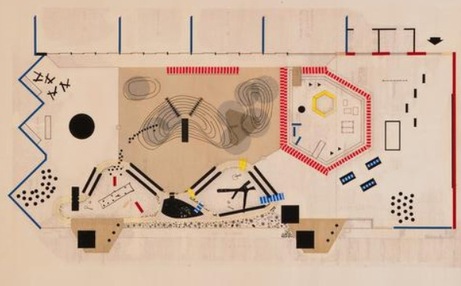Madlener House
4 West Burton Place
Chicago, Illinois 60610
Telephone: 312.787.4071
info@grahamfoundation.org

Former dancer and choreographer Ginger Farley and architect Julie Hacker FAIA will run a one-day workshop to explore the intersection between dance and architecture. A small group of dancers and architects will be invited to participate with the goal of extending the dialogue between the two disciplines.
Ginger Farley has been a dancer, dancemaker, teacher, and advocate for live art since 1978. An early member of Hubbard Street Dance Chicago, she later directed her own company, The 58 Group, with colleague Cameron Pfiffner. Farley now leads the Chicago Dancemakers Forum, practices dramaturgy, and mentors emerging artists. She is a member of the Performance Programs Committee at the MCA, the advisory committee for the School of Theater and Music at UIC, space and programming committees at Links Hall, the advisory board for Arts in Sacred Places, and serves on the Board of Directors at Arts Alliance Illinois.
Julie Hacker is a practicing architect and a Fellow of the American Institute of Architecture. She is a graduate of Wesleyan University, where she majored in psychology and minored in dance, with a strong interest in choreography, which she pursued in New York after college. She returned to Chicago and received her Masters in Architecture at the University of Illinois Chicago, where she was the recipient of the Chicago Women in Architecture Award. She has been a practicing architect for the last 28 years. Her firm Stuart Cohen & Julie Hacker Architects specializes in residential work and has been published nationally and internationally. The work of her practice is the subject of a recent book, Transforming the Traditional, published in 2009.
Please Note: This is a closed event. If you are interested in participating in future workshops, please contact us at mkhimm@grahamfoundation.org.
Image: Kari Job and Jay Franke in a performance by the 58 Group at HotHouse, 2000. Photo: Brian Hill.

In conjunction with the exhibition Experiments in Environment: The Halprin Workshops, 1966-1971, the Graham Foundation is pleased to present the Chicago launch of the Graham-funded book City Choreographer: Lawrence Halprin in Urban Renewal America by landscape architectural designer and urban historian Alison Hirsch. Hirsch will be joined by fellow grantee, architectural historian Eva J. Friedberg to discuss the influences, development, and impact of Anna and Lawrence Halprins’ collaborative workshops.
Friedberg will trace the origins of the Halprins’ partnership, highlighting the parallels between architecture and dance, and the culmination of the couple’s collaborative practice within the setting of the "Experiments in Environment" workshops. Then, Hirsch will then discuss the impact of these workshops on Anna and Lawrence’s subsequent work in the urban context of the late 1960s and 1970s, emphasizing the development and application of Lawrence Halprin's "Take Part" workshop process.
Copies of City Choreographer: Lawrence Halprin in Urban Renewal America (University of Minnesota Press, 2014) are available for purchase in the Graham Foundation Bookshop.
Eva J. Friedberg is a modern art and architecture historian on adjunct faculty at the University of San Diego and Woodbury University School of Architecture. Her essay on the Experiments in Environment workshops, “Collective Movement: Anna and Lawrence Halprin’s Joint Workshops,” appears in the 2012 anthology West of Center: Art and the Counterculture Experiment in America, 1965-1977, published by the University of Minnesota Press. Friedberg’s doctoral dissertation on the early work of Lawrence Halprin closely examines the designer’s development of the RSVP Cycles as a new method for organizing human creative processes and as a guide to collective creativity.
Alison Hirsch is a landscape architectural designer as well as urban historian and theorist. She is Assistant Professor of Landscape Architecture at the University of Southern California and co-founder and partner of Foreground design agency. Her book City Choreographer: Lawrence Halprin in Urban Renewal America was released by University of Minnesota Press in April 2014. The book provides an analysis of the creative process Lawrence Halprin developed with his wife, dancer and choreographer Anna Halprin, and how aspects of this process have the potential to enrich contemporary approaches to structuring the city.
Related Grants: Alison Hirsch, City Choreographer: Lawrence Halprin in Urban Renewal America (University of Minnesota Press, 2014); and Eva Jessica Friedberg, "Action Architecture: Lawrence Halprin's Experiments in Landscape Design, Urbanism, and the Creative Process."
Image: Photographer unknown, participants in “Experiments in Environment," a creativity workshop that served as an experimental precursor to Lawrence Halprin & Associates’ Take Part Process, a community participation methodology, 1966, Kentfield, CA. Courtesy of the Lawrence Halprin Collection, the Architectural Archives, University of Pennsylvania.
For more information on the exhibition, Experiments in Environment: The Halprin Workshops, 1966-1971, click here.

The Sea Ranch is a residential development that stretches ten miles along the Northern California Coast. Beginning in 1963, the American landscape architect Lawrence Halprin led a diverse, cross-disciplinary team of professionals, which included architects Joseph Esherick & Associates and MLTW (Moore Lyndon Turnbull Whitaker), in planning the early development of The Sea Ranch. Their work, acclaimed as early ecological planning and architecture, was published and emulated internationally.
Embodying the ideals of the team, the early work at The Sea Ranch was guided by group meetings, workshops, and a “Locational Score” drawn by Lawrence Halprin. As the project developed, incrementally and with a changing cast of authors, the qualities varied, but Halprin’s Score remains a point of reference. Subsequent workshops led by Halprin and more recent ones conducted by the Commons Landscape Committee have continually added to the understanding of the place and the need for tending a dynamic landscape.
On December 2, Donlyn Lyndon, FAIA, one of the founders of MLTW will discuss the nature of The Sea Ranch and the architecture that has developed there. His talk will draw in part from his acclaimed book The Sea Ranch: 50 Years of Landscape, Architecture, Place and Community on the Northern California Coast (with Jim Alinder, Princeton Architectural Press, 2014) and a recent Architectural Forum panel that Lyndon helped organize and chair for The Sea Ranch 50th Birthday Celebration.
Donlyn Lyndon, FAIA, is the Eva Li Professor Emeritus of Architecture and Urban Design at University of California, Berkeley, and previously headed the Departments of Architecture at MIT and the University of Oregon. In 1997, he received the AIA/ACSA Topaz Award for Excellence in Education. The Sea Ranch Condominium One, which he and his partners in MLTW (Moore Lyndon Turnbull Whitaker) designed, won the distinguished AIA 25 Year Award and is listed on the National Register of Historic Places. Lyndon remains active in practice and has also authored or coauthored numerous publications, including The Place of Houses (University of California Press, 2000); The City Observed: Boston (Vintage, 1982); Chambers for a Memory Palace (The MIT Press, 1996); and most recently, The Sea Ranch: 50 Years of Architecture, Landscape, Place and Community on the Northern California Coast (with photographs by Jim Alinder, Princeton Architectural Press, 2014).
Image: Anna Halprin conducting a "Score for Building Community" at The Sea Ranch, Sept 1, 2014. Photograph by Jim Alinder.
For more information on the exhibition, Experiments in Environment: The Halprin Workshops, 1966-1971, click here.

Los Angeles-based collaborative Lucky Dragons will premiere "RSVP Partita," a performance created for the Graham Foundation and Lampo that treats Lawrence and Anna Halprin's RSVP Cycles and their workshop-based approach to the creative processes, developed in the late 1960’s, as a musical form. Presented in conjunction with the Graham’s current exhibition, Experiments in Environment: The Halprin Workshops, 1966-1971, this new work interweaves score, performance, and evaluation to create an iterative suite for instrumentalists, software, and group conversation.
Lucky Dragons is a collaboration between artists Sarah Rara (b. 1983, Livingston, NJ) and Luke Fischbeck (b. 1978, San Francisco, CA), who have been exploring the nuances of sound as a participatory medium for nearly fourteen years through recordings, performance, software design, workshops, and installations. Their work has been presented in a wide variety of contexts, including the Whitney Museum of American Art (as part of the 2008 Whitney Biennial), the Centre Georges Pompidou, the Walker Art Center, London's Institute for Contemporary Art, MOMA/PS1 and the Kitchen in New York, REDCAT, LACMA, MOCA, and the Hammer Museum in Los Angeles, the 54th Venice Biennale, and the Smithsonian's Hirshhorn Museum and Sculpture Garden, among others. The name "Lucky Dragons" is borrowed from a fishing vessel caught in the fallout from H-bomb tests in the mid-1950s; this incident sparked international outcry, spontaneously generating the worldwide anti-nuclear movement.
This performance is presented in partnership with Lampo. Founded in 1997, Lampo is a non-profit organization for experimental music, sound art, and intermedia projects. Visit www.lampo.org.
Please note: RSVP is required. Event entry is on a first-come, first-serve basis, and seating is limited, so please plan to arrive early. Doors open at 7:30PM.
For more information on the exhibition, Experiments in Environment: The Halprin Workshops, 1966-1971, click here.

On November 19, Graham Foundation grantee Susan Herrington will discuss her new book, Cornelia Hahn Oberlander: Making the Modern Landscape—the first biography of Canadian landscape architect Cornelia Hahn Oberlander, one of the most influential landscape architects of the twentieth century. We are also pleased to welcome Cornelia Hahn Oberlander, who will be joining Herrington for the presentation of the new book.
Cornelia Hahn Oberlander is a landscape architect who has been a pioneer in the fields of sustainability and ecologically-sensitive planning for more than sixty years. Born in 1921, Oberlander fled Nazi Germany at the age of eighteen with her family, and went on to become one of the few women to graduate from Harvard University’s Graduate School of Design in the late 1940s, where she briefly overlapped with American landscape architect Lawrence Halprin. She spent her early years working with modern architects such as Louis Kahn and Dan Kiley, and has continued to collaborate with preeminent architects across Canada and the United States. Her landscape projects include the Robson Square Provincial Government complex and Courthouse in Vancouver (Architect: Arthur Erickson, 1974-1983); the Children's Creative Center for Expo '67 in Montreal, 1967; the Museum of Anthropology at the University of British Columbia (Architect: Arthur Erickson, 1976); and the Vancouver Public Library (Architects: Moshe Safdie Architects, 1995), among others. She is the recipient of many honors and awards, including the International Federation of Landscape Architects Sir Geoffrey Jellicoe Award (2011) and the American Society of Landscape Architects Medal (2012).
Susan Herrington’s research concerns the history and theory of designed landscapes. She is the author of On Landscapes (Routledge, 2009) and Schoolyard Park: 13-Acres International Design Competition (University of British Columbia Centre for Landscape Research, 2002), and has published articles in Architecture and Ideas, Footprint, Landscape Journal, and Landscape Research, as well as numerous chapters in books. She was awarded a Graham Foundation grant for her recent book, Cornelia Hahn Oberlander: Making the Modern Landscape (University of Virginia Press, 2014). Currently, she is writing Landscape Theory in Design to be published by Routledge, and is conducting research on the architect Oskar Stonorov and Walter Reuther, former president of the United Auto Workers Union. Herrington is professor of landscape architecture and architecture at the University of British Columbia in Vancouver, Canada.
Related Grant: Susan Herrington, Cornelia Hahn Oberlander: Making the Modern Landscape (University of Virginia Press, 2014).
Image: Expo '67, An Environment for Creative Play and Learning. Courtesy of Canadian Centre for Architecture, Cornelia Hahn Oberlander Archives.
For more information on the exhibition, Experiments in Environment: The Halprin Workshops, 1966-1971, click here.
Unless otherwise noted,
all events take place at:
Madlener House4 West Burton Place, Chicago
GALLERY AND BOOKSHOP HOURS
2025 Chicago Architecture Biennial
SHIFT: Architecture in Times of Radical Change
Sep 19, 2025–Feb 28, 2026
Wed–Sat, 12–5 p.m.
CONTACT
312.787.4071
info@grahamfoundation.org
Accessibility
Events are held in the ballroom on the third floor which is only accessible by stairs.The first floor of the Madlener House is accessible via an outdoor lift. Please call 312.787.4071 to make arrangements.
Copyright © 2008–2025 Graham Foundation. All rights reserved.
 PREVIOUS POSTS
PREVIOUS POSTS